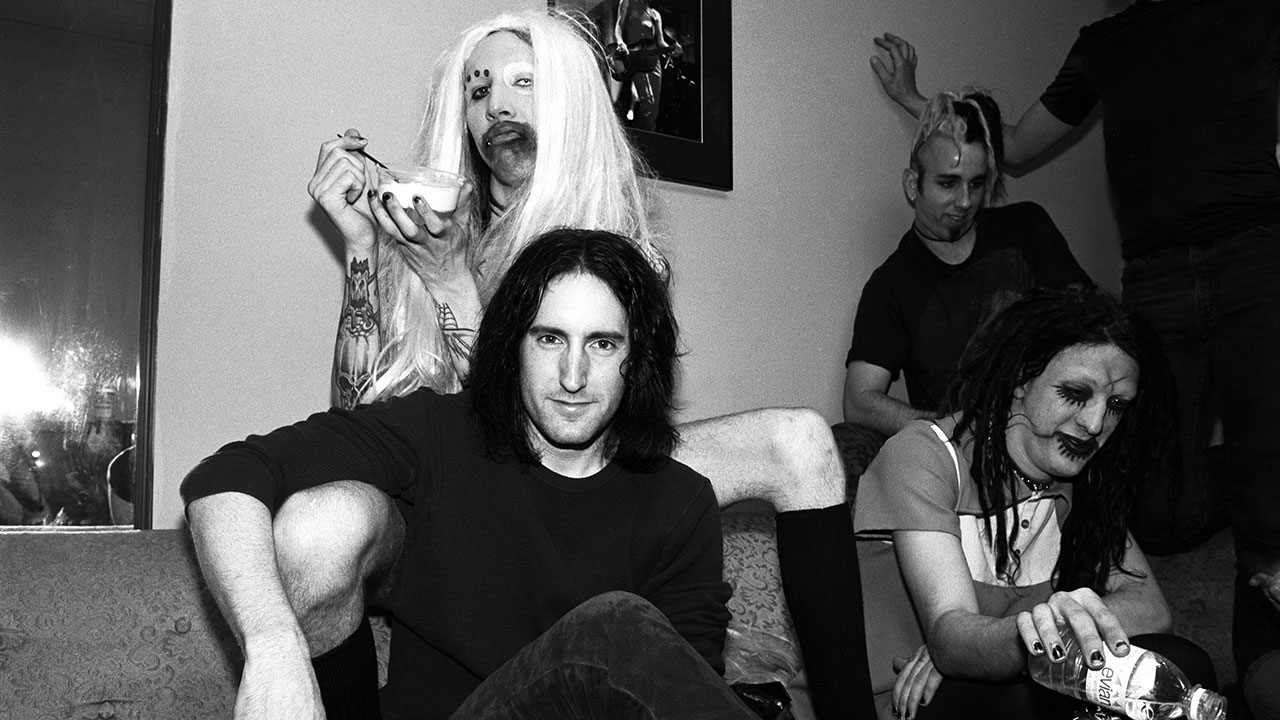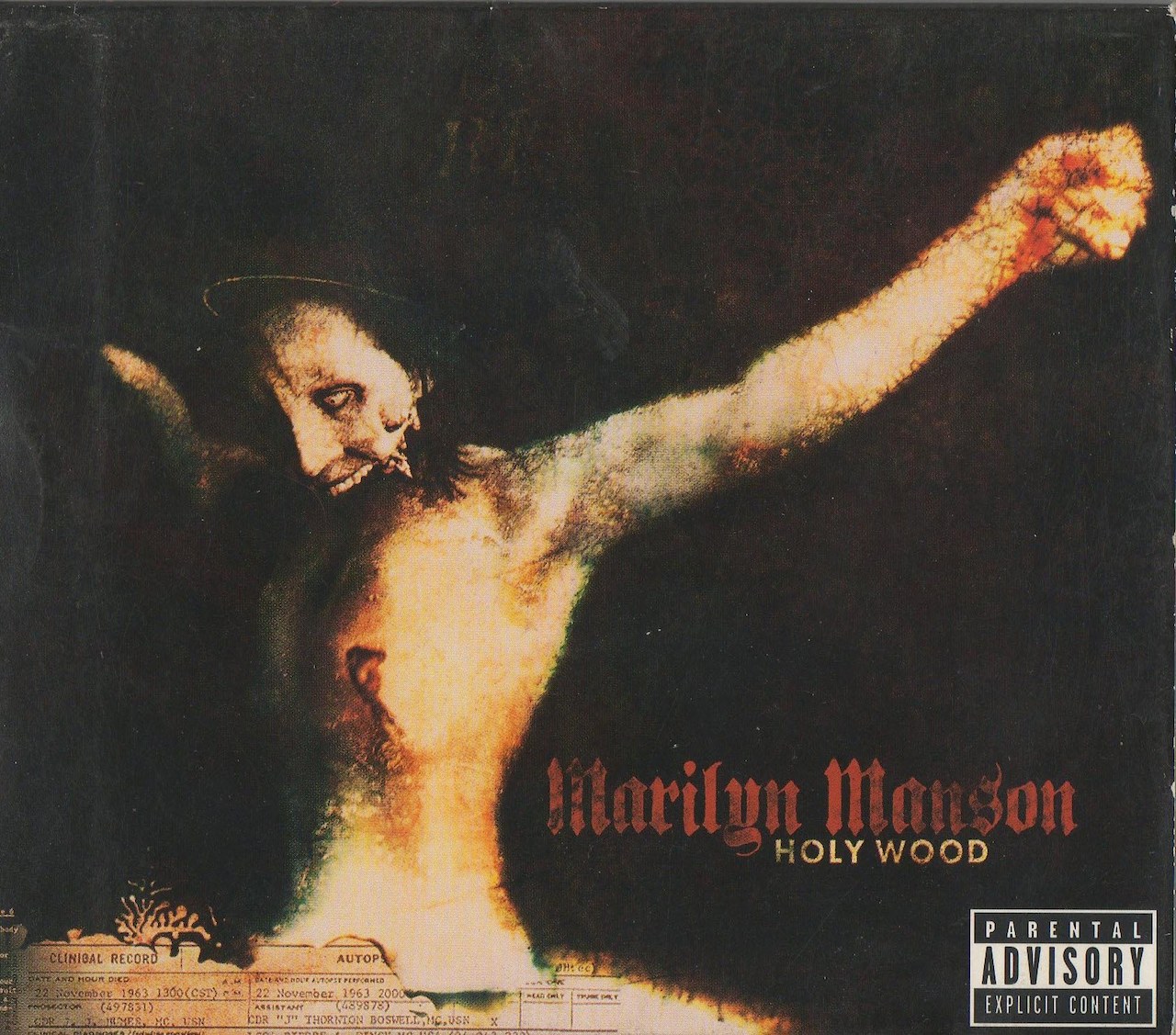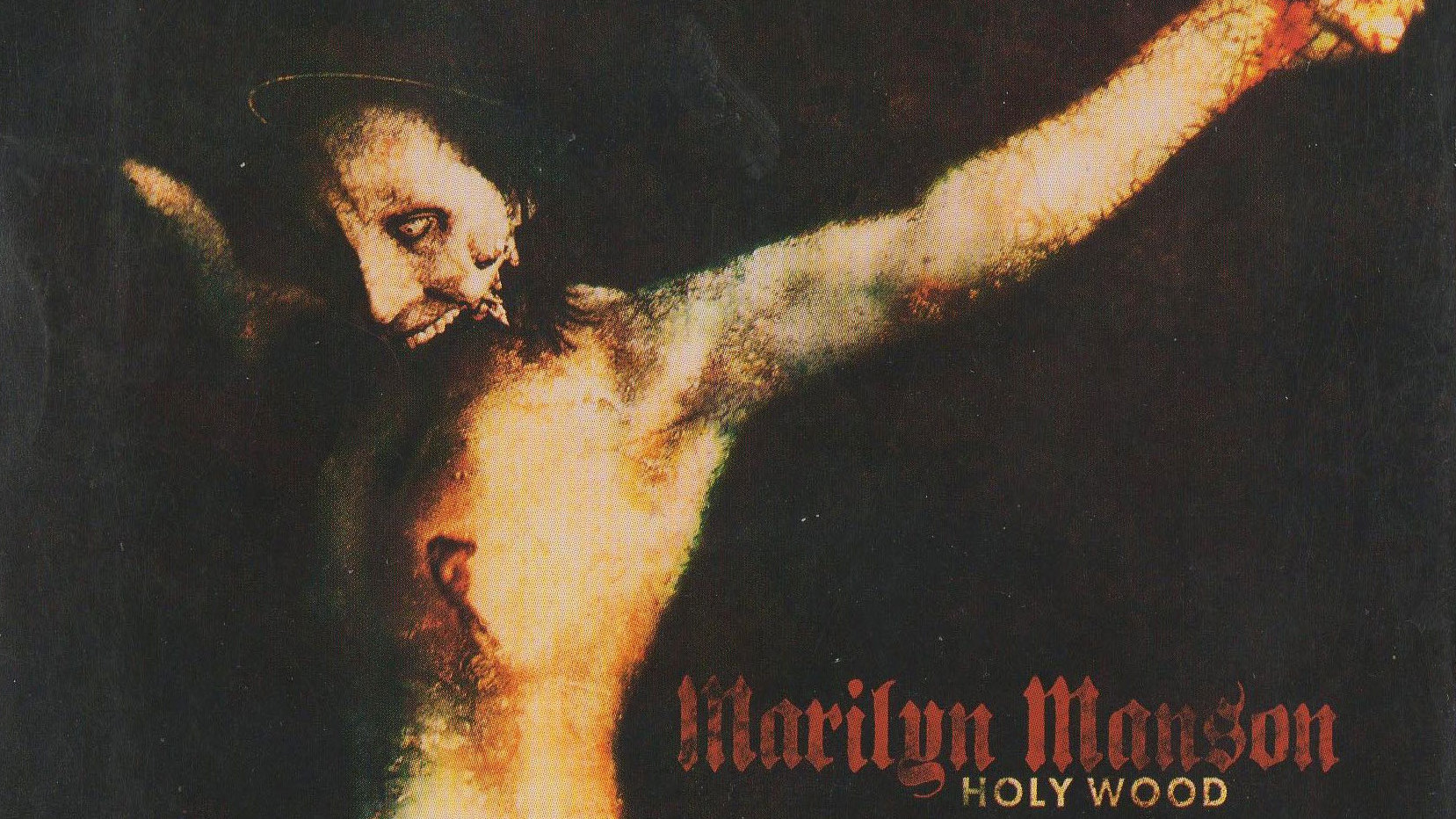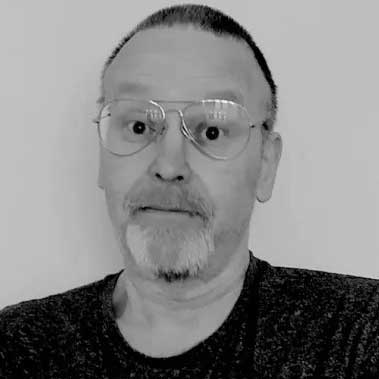To put it in a completely cynical light, the Columbine shootings were exactly what Marilyn Manson needed. By the turn of the century, Manson was no longer Americaʼs demon dog. White trash superstar Eminem had clocked his position and supplanted him.
Mechanical Animals wasnʼt exactly a stiff – it may not have been his best album but it definitely had some of his best songs – but the kids who bought Antichrist Superstar in their millions were expressing their disappointment at the record store tills and in the half-empty venues he played on the subsequent tour.
For Manson, that hardly mattered: he had joined that new aristocracy of the global mediaocracy. Manson was a celebrity and his fame had started to outshine that for which he was actually famous.
Manson had always been adept at using icons – serial killers, movie stars – for his own purposes, juxtaposing them and playing with the imagery. Now he was an icon in his own right. And as with any iconic figure, they are defined as much by those who hate them as by those who worship them.
In the wake of the ʼ99 high school shootings in Columbine, Colorado, when students Dylan Klebold and Eric Harris went on a gun rampage leaving 12 students and a teacher dead, Manson became a national symbol of hatred for middle America, for politicians of the Conservative right and the liberal left and centre, for no-neck Christian fundamentalists, for pro-censorship feminists and for dimwit small town High School principals eager to grab some newspaper headlines.
Desperate to explain why two teenagers would turn into mass murderers, commentators sought scapegoats in the usual places: violent films, video games and ʻthe gothic movementʼ. Bands like KMFDM, Filter and My Life With The Thrill Kill Kult turned on their TVs to discover that they were part of a Satanist plot to brainwash the Americaʼs youth because they were included in Klebold and Harrisʼs record collections.
Manson was singled out for special treatment: despite the fact that the two misfits had been the victims of bullying, had easy access to serious guns, it was the fact they were said to be fans of Manson that investigators jumped upon as a likely motive. When Manson cancelled his Colorado show “out of respect for the dead” (a statement by the showʼs promoter, not Manson) it was like an admission of complicity.
According to one Associated Press report: “Parents in Grand Blanc, Michigan claimed that devotees of Marilyn Manson were ʻterrorisingʼ school students there and asked school officials to ban dress, jewellry and other attire associated with him. According to the parentsʼ letter, some members of the group threatened to sacrifice one student and told others they want to drink their blood. They also have read the Satanic bible aloud and distributed Satanic literature in school.”
Christian-right demagogue Pat Robertson, said of Manson: “This music incites people to murder, to rape, to pillage.” Whether he was referring to Mechanical Animals, Antichrist Superstar or Portrait Of An American Family was not specified.
Columbine was, said Manson, “probably the only event since the Kennedy assassination to really shock America. Itʼs grotesque that they used it as a toy to toss around to set up the election – the only thing Bush and Gore were talking about was violence in entertainment and gun control. I may have nihilism in my music, and it may not be pretty, but at the same time I donʼt think I behaved in such a disrespectful way as these other people.”
Mansonʼs defence was articulate and angry. He was not about to be saddled with the blame for this or any other teen gun rampage. Interviewed in Michael Mooreʼs Oscar-winning documentary Bowling For Columbine – a film that Manson says changed the way he was perceived in America – the singer was asked what heʼd have said to Klebold and Harris. He said that he wouldnʼt have said anything. Heʼd have listened.
“The media held me responsible for basically every act of violence that happened
in America, no matter what. So what should I do? Stand there and let them fuck me over or turn around and smash their teeth in? I decided that Iʼm going to do the latter. But I’m going to do it with Holy Wood and I’m going to do it so hard that theyʼll wish theyʼve never been born,” he said.
“I hope that this is America’s worst nightmare and I hope that we can disrupt the regimented lifestyle people have set out for themselves,” he told MTV, as he spoke about the concept of his fourth record. "That’s what rock’nʼroll was intended to be and thatʼs what I am and that’s what I’m always going to be and the day that I’m not is the day that I quit.”
Holy Wood (In The Shadow Of The Valley Of Death) was Mansonʼs attempt to create a masterpiece. It was to be the third part of the trilogy that began with Antichrist Superstar. There was a movie script, a whole big concept. Manson was perhaps smarting at the accusation in some quarters that he was Trent Reznorʼs puppet.
The Nine Inch Nails frontman, in making The Downward Spiral, had established himself as the voice of Generation X malcontents, landed on the cover of Time magazine and garnered both critical and commercial adulation. The two had fallen out and were running their own private cold war. Manson had once been the pupil, now he wanted to show teacher a thing or two.

Holy Wood was, he told Rolling Stone, a bit of a ʻprequelʼ to Antichrist Superstar and Mechanical Animals. It was about “a boy who wants to become part of the world that he doesn't feel adequate for, and the bitterness and rage become a revolution inside him”.
“In a way, I am declaring war on the United States,” he said. “Not on everybody, but I am attacking the shallowness of the entertainment industry, their self-congratulatory attitude, their beliefs that they can never do wrong, that theyʼre always right, that theyʼre the centre of the universe. And I am living right in the middle of the entertainment industry here in Hollywood.”
The album was steeped in images of martyrdom from the crucifixion of Christ to the assassinations of John Lennon and John F Kennedy. The cover, which depicted a crucified Manson, his lower jaw missing, was a sly comment on censorship that was, inevitably, censored by the moral majority boycott-threatened chain stores who sold it in alternative packaging.
“The irony is that my point of the photo on the album was to show people that the crucifixion of Christ is, indeed, a violent image,” he wrote on his website. “In fact, the picture itself is composed of a statue of Jesus taken from a place of worship. My jaw is missing as a symbol of this very kind of censorship. This doesnʼt piss me off as much as it pleases me, because those offended by my album cover have successfully proven my point.”
The title was inspired by the ʻ89 Mexican film Santa Sangre (Holy Blood) by Alejandro Jodorowsky, a fantastic, surreal anti-clerical film by one of the few living geniuses of cinema. Jodorowsky was set to direct the film of Holy Wood.
When Manson entered the studio with Dave Sardy producing, he also roped in Bon Harris of 80s industrial duo Nitzer Ebb on programming – possibly a comment to Reznor that while NIN were industrial-lite, he was going to the dark source of industrial rock – and cut an album of 19 twisted tracks layered with S&M imagery, references to The Beatles (particularly their eponymous ʻWhiteʼ album) but most of all to Columbine.
Opener Godeatgod is about the assassination of John F Kennedy: ‘Dear God the paper says you were the king in the black limousine/Dear John and all the kingʼs men canʼt put your head together again.’ The Kennedy assassination crops up again in Target Audience (Narcissus Narcosis) (‘Am I sorry you killed the Kennedys and Huxley too? …Am I sorry for Booth and Oswald, pinks and cocaine too?’), A Place In The Dirt (‘Put me in the motorcade, put me in the death parade/Dress me up and take me, dress me up and make me your dying God’) and King Kill 33°.
The idea of Kennedy as a king ritually sacrificed was a long standing ʻconspiracy theoryʼ that Manson was well aware of (briefly: Kennedy was killed as part of a Masonic ritual of renewal the way that ancient Celtic kings were put to death after a fixed period in office).
Holy Wood remains Mansonʼs densest and most poetic album, though the references are obscure, drawn from the paranoid underground of conspiracy theory, occult interpretations of history and religion and Hollywoodʼs own dark past. There are references to Jacqueline Susannʼs classic trash novel Valley Of the Dolls (‘Iʼm someone stupid just like you/The valley of the dolls is the valley of the dead’ from Born Again) and the Manson Family murders bubble away just below the surface.

The Love Song is Mansonʼs jaundiced view of what it is to be American: ‘Do you love your guns?’ (yeah) ‘God?’ (yeah) ‘The government?’ (fuck yeah). The Fight Song is Mansonʼs declaration of war on religion: ‘But Iʼm not a slave to a God that doesnʼt exist, And Iʼm not a slave to world that doesnʼt give a shit.’ Disposable Teens, the “crunchy cousin” of The Beautiful People, says most about Columbine: ‘I wanna thank you mom, I wanna thank you dad/For bringing this fucking world to a bitter end/I never really hated a one true God/But the God of the people I hated/You said you wanted evolution, the ape was a great big hit/You say you want a revolution, man, and I say that youʼre full of shit.’
It also echoes The Beatles song Revolution 1 from The Beatles’ ʻWhiteʼ album, just as the eerie closing track Count To Six And Die (The Vacuum Of Infinite Space Encompassing) seems to be an attempt to recreate the feel of Revolution 9, also on that album.
There are so many circles that you can close, so many dots that you can join that add up to other meanings. The White album links to the Manson murders (according to prosecutor Vincent Bugliosi, in his book Helter Skelter, Charles Manson believed that The Beatles were sending him hidden messages in their music). The ʻvalley of deathʼ could refer to Death Valley, just outside Los Angeles where the Manson family holed up.
But itʼs Columbine that drives the record. Itʼs there like a dark shadow over everything, even whether it was intentional or not. As he told Metal Hammer: “I could say after last year, after the many attacks that came upon me for teenage violence, it gave me a lot of fuel and a lot of anger that I needed to release.
I would say anger is a very important state of mind on this record. As far as my mental state, I really put myself in a lot of interesting positions for making this album. I managed to drink 12 bottles of absinthe, which Van Gogh had drunk when he cut off his ear. Physically and mentally, I took myself farther than I had ever taken myself.”
Musically, Holy Wood would have made a great 40 minute album, like Bowieʼs Diamond Dogs or Adam & The Antsʼ neglected classic debut Dirk Wears White Sox – a generally unacknowledged influence on MM. Or even NINʼs Pretty Hate Machine, or all of the classic albums that he desperately wanted this to be.
As it is, itʼs flabby, with tracks like Count To Six And Die (The Vacuum Of Infinite Space Encompassing) weigh down the obvious strong points like The Fight Song and Disposable Teens. You could almost chop the record clean in half and have one mean snarling black apocalyptic glam rock record.
When Holy Wood was released in November 2000, sales were modest. Mechanical Animals had entered the Billboard album charts at No.1 before sales fell off sharply in comparison to its predecessor Antichrist Superstar. But Holy Wood crept in at an apologetic No.13, selling 117,000 in its first week of release. It finally went gold in 2003. With Antichrist Superstar platinum by that point (one million units), it was therefore perceived as a commercial failure.
With the follow-up record, The Golden Age Of Grotesque, Manson appeared yet again to have completely reinvented himself and overhauled his concepts and themes. But had he? It was actually little different to Holy Wood, and some of the same themes – the fakeness of the media and its hunger for martyrs to feed it – were still there and are as apt as ever. Just as they are today.

